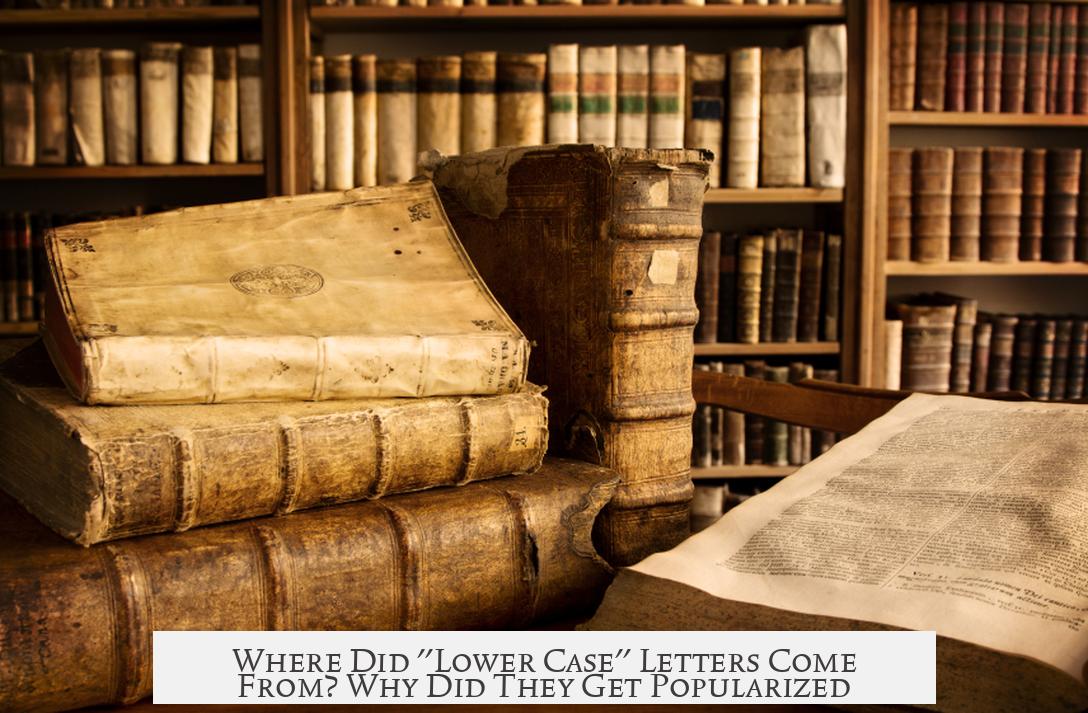Lowercase letters originated from the Carolingian minuscule, a script developed during Charlemagne’s reign to improve legibility and standardize writing across his empire. This script evolved from earlier Roman handwriting traditions that aimed at faster and clearer writing with distinct letter forms. Lowercase letters gained widespread use due to this standardization and the practical needs of scribes copying texts efficiently.
The roots of lowercase letters trace back to improvements made in Roman handwriting. Originally, Roman inscriptions used capital letters, which were not practical for fast writing. Scribes adapted by creating simpler forms. Around the 3rd century, the use of ascenders (strokes rising above the main body of a letter) and descenders (strokes extending below) appeared. This style helped distinguish letters more clearly.
The half-uncial script emerged during this period as a step towards lowercase forms, though it did not yet fully distinguish between majuscule (capital) and minuscule (lowercase) letters. Further evolution happened during the 7th and 8th centuries in the Merovingian script, notable for its larger ascenders and descenders, mainly for aesthetic reasons.
By the 9th century, a convergence of various writing styles such as Merovingian and Insular scripts led to the development of Carolingian minuscule. This script introduced the clear distinction between uppercase and lowercase letters, making texts easier to read and write. The motivation for this change came primarily from Charlemagne’s efforts to unify his realm’s education and communication.
Charlemagne himself, although illiterate, understood education’s value and encouraged the establishment of schools and script reform known as the Carolingian Renaissance. He needed a legible, uniform writing system for administration and scholarship. The Carolingian minuscule fulfilled this need by offering a clean, standardized alphabet that clerics and scribes used to copy classical and religious texts.
Monks played a crucial role in this process during the Carolingian Renaissance by transcribing manuscripts. Paper or parchment was costly, so writing smaller and more legibly reduced book size and conserved materials. This practical need helped popularize lowercase letters as they allowed for compact and clear text, improving efficiency for scribes and readers alike.
This new script rapidly became the status quo because literacy was limited to clergy and a few elites. Their writing style set the standard for official documents and literature. Previously, scripts across Europe were diverse and sometimes unintelligible outside local regions, hampering communication. Carolingian minuscule resolved this by creating a uniform alphabet understood throughout the empire.
The Carolingian minuscule remained dominant until its gradual replacement in the 13th century by Gothic Blackletter, which was more ornate but less legible. The Renaissance sparked a revival of Carolingian minuscule, as scholars rediscovered its clarity and elegance. From this rebirth, the modern Latin alphabet and its lowercase letters evolved, shaping contemporary writing systems.
The terms “uppercase” and “lowercase” do not reflect letter size in their origin but the physical storage method used by early printers. Capital letters were kept in larger wooden cases placed above smaller cases holding the minuscule letters. This spatial arrangement gave birth to the names we use today, even though the distinction in shape and function was established long before printing.
| Aspect | Details |
|---|---|
| Origin | Carolingian minuscule created during Charlemagne’s reign (8th–9th century) |
| Predecessors | Roman cursive, half-uncial, Merovingian script |
| Key Features | Ascenders and descenders for letter clarity, separation of upper and lower case |
| Popularization | Standardized, more legible script for administration and education |
| Role of Monks | Transcribed texts smaller to save space and materials |
| Terminology | From printer’s physical letter cases, not letter size itself |
- Lowercase letters come from Carolingian minuscule developed in Charlemagne’s era.
- Roman handwriting evolved to include ascenders and descenders improving readability.
- Carolingian script provided a clear, uniform alphabet for education and administration.
- Monks’ need to conserve space favored smaller, legible letter forms.
- The names uppercase and lowercase originate from printer’s cases, not letter size.
Where Did “Lower Case” Letters Come From? Why Did They Get Popularized?

You ever wonder why some letters are big and some are small? Why do we call them capital and lowercase? The answer is a fascinating tale dating back over a millennium, woven with royalty, monks, and scribbles. The “lowercase” letters come from a script known as Carolingian minuscule, developed during Charlemagne’s reign to improve reading and writing across his vast empire.
Let’s unravel this story with some context and quirky nuggets.
The Origins of Lowercase Letters: Enter Charlemagne and His Renaissance
Though Charlemagne himself was illiterate—yup, the guy who shaped much of early Europe couldn’t read or write—he *got* that education mattered. In fact, he kicked off a huge educational revival known as the Carolingian Renaissance. He established schools, boosting literacy and cultural unity across his kingdom.
One practical problem emerged: the Roman letters they used back then were designed mostly for carving on stone. They looked neat, but weren’t suited for quick handwriting.
Here’s the deal—Roman script was capital letters only. Writing fast with those blocky letters led to a mess of scribbles that were hard to distinguish. How do you tell an O from a D if the handwriting’s sloppy? The solution was simple: make writing easier and clearer by adding little flourishes. Some parts of letters became longer—lines that go up are called ascenders, those that go down are descenders. These features added clarity.
Scribes in the 3rd century started playing with these ideas, resulting in half-uncial script, which introduced many letter shapes closer to what we now recognize as lowercase. By the 7th or 8th century, styles like the Merovingian script showed even bigger ascenders and descenders for aesthetic reasons.
The Carolingian Minuscule: The Birth of Our Modern Lowercase
By the 12th century, several writing styles converged and evolved into Carolingian minuscule. This script introduced a clear distinction between what we now call uppercase (majuscule) and lowercase (minuscule) letters. The forms were neat, more uniform, and significantly easier to read.
“Legibility and standardization were key.” Charlemagne needed a unified script to govern a sprawling empire properly.
This script became the backbone for literature, religious texts, and official documents. It wasn’t just about style—it was about clear communication. Before Carolingian minuscule, writing styles varied wildly, and some letters differed between regions. Trying to read a 9th-century letter could be a nightmare for even the sharpest minds.
Why Did Lowercase Letters Get So Popular?
Several practical reasons pushed lowercase letters into the spotlight:
- Space-saving for monks: Monks copying texts valued every inch of parchment, which was expensive. Smaller letters let them fit more text onto a page.
- Legibility: Lowercase letters made texts easier to read quickly and accurately.
- Standardization: Charlemagne’s schools promoted the Carolingian minuscule as *the* script, setting a standard across his empire.
- Accessibility: The only literate people initially were clergy and nobility. Their choice naturally became the norm.
Think of it as the first widespread font makeover. When the “cool kids” adopted lowercase letters for practicality, the rest of society followed suit.
A Quick Pit Stop: What Happened Next?

Carolingian minuscule ruled for centuries but eventually got replaced by the elaborate Gothic Blackletter script in the 13th century—those dense, dramatic letters you see in medieval manuscripts. Fortunately, Renaissance scholars rediscovered Carolingian script, recognizing its clarity and practicality. From their rediscovery sprang the modern alphabet with its familiar uppercase and lowercase letters.
And the Name “Lowercase”—Is It Just About Size?
You might think “lowercase” refers simply to small letters, but the story is more mechanical. In early printing shops, capital (uppercase) letters lived in the taller, upper case of type racks. The smaller letters, the ones that became our “lowercase,” rested in the lower case of the racks—literally below the capitals. This practical storage system gave us the terminology we use today, not the usage itself.
Practical Takeaway: Why Should You Care?
Knowing where lowercase letters come from is more than trivia. It shines light on how humans adapt tools for communication. The lowercase letterforms didn’t appear overnight—they evolved to solve real-world problems:
- Speed: Writing faster without losing clarity.
- Space: Saving costly parchment and making books portable.
- Standardization: Making communication across vast regions possible.
Next time you draft an email or jot down notes, remember—the humble little lowercase letters in your keyboard stand on centuries of innovation, conscious effort, and cultural shifts.
Questions to Ponder
Is our digital age pushing us toward yet another evolution of letterforms? Could emojis and shorthand texts be the new Carolingian minuscule? What future scripts could emerge to help us communicate faster and clearer?
One way or another, lowercase letters remind us: even tiny details have big stories.
Where do lowercase letters originally come from?
Lowercase letters originate from the Carolingian minuscule script. It was developed during Charlemagne’s reign to create a clearer, uniform writing style across his empire.
Why did Charlemagne promote the use of lowercase letters?
Charlemagne wanted a legible, standardized script for education and communication. His support helped Carolingian minuscule spread, improving reading and writing clarity throughout Europe.
How did ascenders and descenders influence lowercase letters?
Roman cursive introduced ascenders and descenders—longer lines above or below letters. This helped distinguish certain characters and shaped the look of modern lowercase letters.
Why did monks prefer smaller writing during the Carolingian Renaissance?
Monks copied manuscripts on expensive materials. Writing smaller saved space and paper while keeping texts readable, which boosted the use of lowercase letters.
Where does the term “lowercase” come from?
The names “uppercase” and “lowercase” come from printing presses. Capital letters were stored in upper racks, while smaller letters were kept in lower racks—hence the terms.




